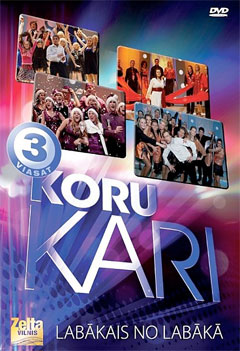
With choir music and choir performance being so popular in Latvia, not to mention a part of the national heritage, it was inevitable that a reality series based around choir singing would appear. The show “Koru kari” (Choir Wars), produced by television channel TV3, was quite a sensation in Latvia. Seven choirs—each from a different city in Latvia, each led by a popular singer, and each given a unique color to identify themselves—competed for victory.
As on other performance-based reality shows, judges would give their opinions on the choirs’ performances, viewers could call in and vote for their favorite choir, and periodically one of the choirs would be voted off until only one choir was left and was declared the winner. The highlights of the first season of the show were collected on the DVD Labākais no labākā.
The seven choirs participating were Ieva Akuratere (solo singer and singer for the rock group Pērkons) and the White Riga Choir, Olga Rajecka (solo singer and singer with Latvian groups such as Turaidas roze and Eolika) and the Violet Lielvārde Choir, Dzintars Čīča (solo singer) and the Blue Talsi Choir, Atis Auzāns (solo singer) and the Orange Daugavpils Choir, Chilli (solo singer) and the Red Liepāja Choir, Miervaldis Jenčs (one of the Latvian Three Tenors) and the Green Sigulda Choir, and Arnis Mednis (solo singer) and the Yellow Rīga Choir.
Having not ever seen the show while it was running, but having heard much about it, I figured I should check out what all the fuss was about, since many in Latvia were captivated by the show, discussing who had the best performance, who should be eliminated, who was unfairly eliminated, and the regular discussions that accompany these types of shows.
On the DVD, the first thing that becomes obvious is that these were not choirs in the traditional Latvian sense. For the most part, the choirs perform popular songs and not Latvian choral classics. Also, the performances do not really strike me as true choir performances. They are more “star and a bunch of backing vocalists” performances. Four-part harmonies are minimal. Of course, with this being a television show, the visual aspect is also important. In addition to singing, we get choreography and the occasional costume.
The songs performed are pretty much as one would expect, with not much deviation from the original. This is a bit of a shame, as the highlights of the DVD are the songs that give a new spin to existing songs and manage to surprise you. Unfortunately, there are too few of those kinds of performances. Rajecka and the Lievārde Violet Choir, the eventual second-place finishers, provide two of the better moments of the show. One is their hip-hop reinterpretation of the Latvian folk song “Rikšiem bērīt es palaidu” (goofy dancing notwithstanding). The other is their rearrangement of a slightly more obscure Čikāgas piecīši tune “Bitītes,” which makes a rather surprising segue into the Mission: Impossible theme.
The winners, the Daugavpils Orange Choir led by Auzāns, provide a memorable moment with their performance of the Latgallian folk song “Kur gaismeņa.” Čīča, himself of Roma descent, and his choir perform the Roma song “Jelem, jelem.” Perhaps one of the only actual choir songs to get a performance is Song Festival favorite “Saule, Pērkons, Daugava” (composer Mārtiņš Brauns, lyrics by Rainis), performed by Akuratere and the White Riga Choir.
The DVD also has occasional “pop up” notes on the show, such as the fact that an impressive 1.39 million viewers watched the first season. While interesting, there are too few of them, and they get repeated over and over again. Additionally, it would have been helpful to maybe have a brief documentary about the show and how it works. No mention is made of the judges, for example. Also potentially interesting would have been to find out how the choirs chose their songs, or maybe comments from the leaders of the choirs on the whole ordeal and their thoughts on it.
For those interested in further exploration, both Auzans and Rajecka and their respective choirs have released compact discs of their choir performances
I guess I was expecting more than just the slightly rearranged pop songs that make up the bulk of this collection, and not many surprises along the way. Of course, since this is television, the visual element becomes almost more important than the musical element. The choirs all sing great, and there are a few interesting tunes in the set, but the choirs could have been utilized in a better way, rather than simply being used as backing vocalists. The show was still a big hit. The second season, from what I have heard, was even more of a spectacle than the first season. But in the end, I could not quite figure out what all the fuss was about.
Details
Labākais no labākā
Koru kari
MICREC, 2009
MRDVD017
Notes: Region 0 encoded.
© 1995-2024 Latvians Online
Please contact us for editorial queries, or for permission to republish material. Disclaimer: The content of Web sites to which Latvians Online provides links does not necessarily reflect the opinion of Latvians Online, its staff or its sponsors.




